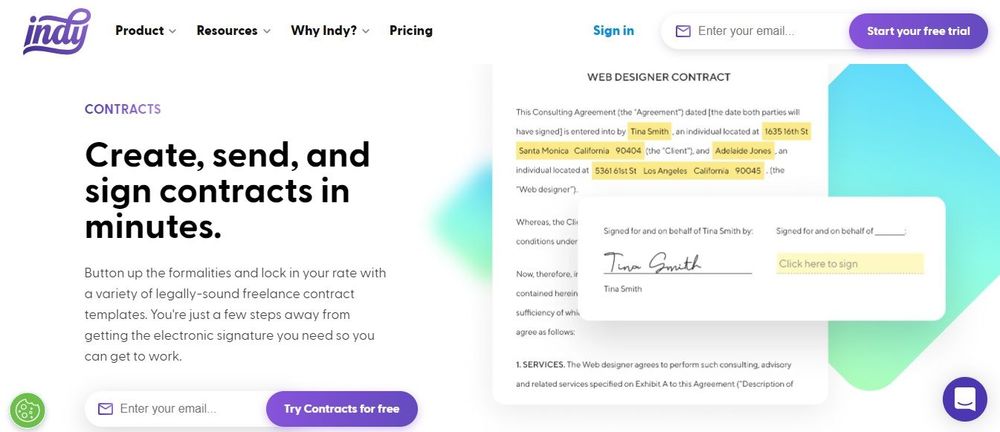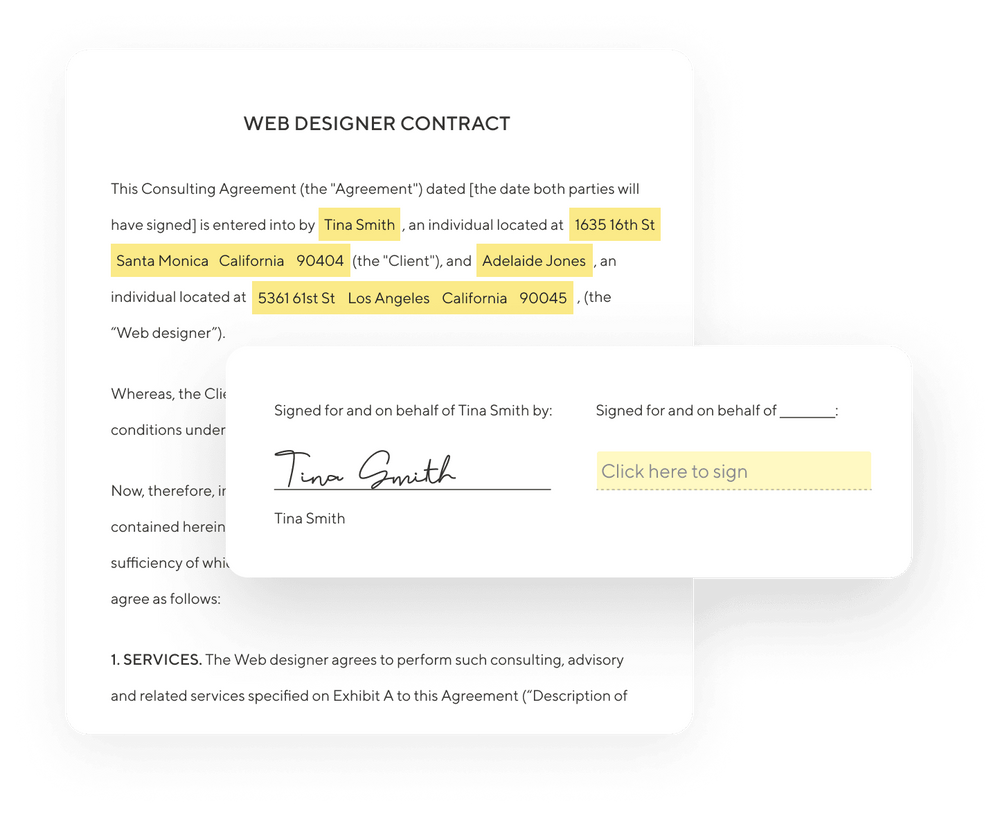There is not much of a bigger buzz for a freelance graphic designer than to land a new client. To know your graphic design services are in demand is some serious validation. If you're new to this, it's easy to neglect one of the most important considerations; the contract! Of course, it would be cynical to assume that every client will try to rip you off. It is a possibility, though. A contract is the best way to ensure this cannot happen and that you are likely to meet the client's expectations.
Did you know that historians are aware of a contract that is 4,300 years old? The contract in question relates to the sale of a slave and its contents may not make for palatable reading. However, it shows that people have recognized the importance of contracts since long before freelance graphic design was even a concept.
Why is a contract essential for freelance graphic design projects? Let’s get into it.
Introduction to freelance graphic design contracts
A freelance graphic design contract is essential for both the designer and the client so both can make their expectations clear for the project. It will include a project description along with legally binding terms that protect both parties. Freelance designers need contracts as much as any other professional freelancer.
Understanding the purpose of contracts in freelance work
A freelance design contract protects both parties legally and sets up expectations, meaning everyone agrees from day one. A graphic design agreement will ensure effective workflow and good communication throughout. It is a legally binding document that will protect you if the client does not pay for any reason. It will also help to gain the client's trust in you as a professional graphic designer.

Key elements of a freelance graphic design contract
A freelance graphic design contract will often have to include a lot of information, so both you and the client are fully protected. As a general idea, though, it should include:
- Project overview - A basic summary of what the project will involve
- Scope description - The services that will be included within this project; what you will provide and what the client will need to contribute
- Deliverables - This should include a timeline with dates on which the client can expect each element of the project to be delivered
- Client responsibilities - What you expect from the client in return
- Payment details - How and when should the client pay you
- Copyright ownership terms - The protection of intellectual property
- Revision details - How many revisions will be allowed if the client is not completely satisfied?
- Client approval process - Who will make the final decision on approval and how will this be indicated?
- Confidentiality agreement - Assurance that any confidential information will be kept as such
- Arbitration agreement - If any disputes take place during the process how will they be settled?
- Termination plan - What will be the process if either you or the client needs to stop work on the project
- Space for signature - The contract will need to be signed by both you and the client when both parties are happy with the entire agreement
Now let's look at some of these in slightly more detail.
Negotiating terms and conditions in a graphic design contract
When negotiating terms and conditions for a freelance contract, bear in mind that the client's wishes may not match your own. This is Ok, but as it will be a legally binding contract, you do not want to agree to terms that will cause you problems just to be polite. We all love to avoid conflict, but the negotiation stage is when you have to set out your needs. Any reasonable client will have some flexibility, but you have to be reasonable too. Negotiation is about compromise rather than winning a battle!
Handling payment terms and schedules in a graphic design contract
You need a detailed payment schedule in place. Disputes over payment are one of the biggest potential headaches for you or your client, but if everyone is clear on what to expect, then difficulties should be few. How will you get paid? Is a deposit required, and how much? How many payment milestones will there be, and if a deadline is missed, what will happen? If an agreement on this is signed by both parties, it should be relatively easy to settle any disputes.
Protecting your intellectual property rights in a graphic design contract
For intellectual property, it can be a minefield! On the one hand, you worked hard to create the design, so you want to retain the rights. On the other hand, your client paid you money to come up with it, so they will be keen to have ownership. As with all elements of the contract, negotiation is key. Make sure you clearly set out your expectations when it comes to intellectual property. That way, everyone is on the same page, and there should be no arguments down the line.
Dealing with changes and revisions in a graphic design contract
Neither you nor the client will want endless revisions to be made with the project. This will only waste time for you both. Therefore it is important to set out the terms very clearly when it comes to revisions, only allowing a certain number. If you are both very clear on what you want from the start then not many revisions should be needed. It is unlikely the design will be perfect the first time but only a few tweaks should be necessary if expectations are understood from the beginning.

Understanding termination clauses in a graphic design contract
With any design project, once a contract is in place you would hope there would be no need to walk away from it. That being said, sometimes there are circumstances in which either you or the client may need to terminate the contract. It is crucial for any solid graphic design contract to set out the terms and conditions for this. Do both you and the client have the right to terminate the contract? Is any payment necessary in order to do so? Again, it's all about negotiation.
Exploring different options for dispute resolution in a graphic design contract
Of course you will enter into freelance design contracts hoping that there will be no disputes. It builds trust for both you and the client though if a process is put in place for if there should be any issues. This should be pretty straightforward:
- The best option for all concerned is if you can settle the dispute between you without the need for arbitration
- If there is a dispute that requires arbitration there may be an option that does not involve the courts if you can both agree on one
- A last resort would be to get the courts involved. If this is necessary, then both parties will usually have to cover their own legal costs. Nobody will want to go through the courts if it can be avoided
Protecting yourself with liability clauses in a graphic design contract
Lawsuits are what everyone dreads and are the reason everyone can seem so keen for you to sign a waiver before you take part in any activity in the modern era. Being sued, even if you win the case, is time consuming and stressful. Therefore it is necessary to put liability clauses in place for a graphic design contract to outline your legal responsibilities as well as what you will not be liable for. This may seem like a mind-numbing part of the process but it's very important to get it right to avoid potential legal battles!
Handling confidentiality and nondisclosure agreements in a graphic design contract
A nondisclosure agreement is basically just to say that you will not share any confidential information with anyone who does not need to see it. The client's intellectual property will remain safe, as will yours.

Online resources for creating and managing contracts
Indy offers an excellent online contract tool to help simplify what can be a very complicated process. Create a professional looking contract that contains all the relevant information in quick time. If you have not put a contract together before it may be worth seeking legal advice from someone who specializes in graphic design contracts just to make sure you are protected.
Tips for negotiating and communicating effectively with clients about contracts
Effective negotiation relies on a few key things:
- Forward planning - It is essential that you are clear on what you want from the negotiations before you enter into them. Set out your goals and how much you are willing to compromise before it removes personal benefit.
- Listen - If someone feels understood they will enter into an agreement with confidence and trust. Make sure you listen to your client's needs and if there is anything you do not agree with explain why. Be willing to negotiate.
- Aim for a win-win - Unless both you and the client are on exactly the same page straight away it's unlikely the contract will be 100% to either of your liking. Be prepared to compromise but know when you may need to back out of negotiations. If you stand to lose heavily from an agreement it is not worth entering into. If both parties are willing to negotiate then a solid agreement that benefits everyone involved should be reachable.
Resources for freelance graphic designers to learn more about contracts and legal issues
There are plenty of online resources to help you understand the legal issues around freelance graphic design contracts. Check out this website where you can find plenty of useful information in one place.
Wrapping up
We covered the key elements every freelance design contract should have, some tips to help you negotiate contracts effectively, and provided some additional resources to help you learn even more about this topic. Having read through all of this information your head may be swimming!

Contracts can be complex and there is a lot to consider, which is why Indy has created a range of templates to guide you through the process in a way that is easy to understand. Take a look and you will find the whole thing a lot less intimidating!



